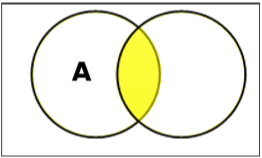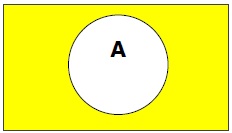Venn Diagrams
Venn diagram, invented in 1880 by John Venn, is a schematic diagram that shows all possible logical relations between different mathematical sets.
Examples

Set Operations
Set Operations include Set Union, Set Intersection, Set Difference, Complement of Set, and Cartesian Product.
Set Union
The union of sets A and B (denoted by ) is the set of elements which are in A, in B, or in both A and B. Hence, .
Example − If and B = , then . (The common element occurs only once)

Set Intersection
The intersection of sets A and B (denoted by ) is the set of elements which are in both A and B. Hence, .
Example − If and , then .

Set Difference/ Relative Complement
The set difference of sets A and B (denoted by ) is the set of elements which are only in A but not in B. Hence, .
Example − If and , then and . Here, we can see

Complement of a Set
The complement of a set A (denoted by ) is the set of elements which are not in set A. Hence, .
More specifically, where is a universal set which contains all objects.
Example − If then

Cartesian Product / Cross Product
The Cartesian product of n number of sets denoted as can be defined as all possible ordered pairs where
Example − If we take two sets and ,
The Cartesian product of A and B is written as −
The Cartesian product of B and A is written as −
Power Set
Power set of a set S is the set of all subsets of S including the empty set. The cardinality of a power set of a set S of cardinality n is . Power set is denoted as .
Example −
For a set let us calculate the subsets −
- Subsets with 0 elements − (the empty set)
- Subsets with 1 element −
- Subsets with 2 elements −
- Subsets with 3 elements −
- Subsets with 4 elements −
Hence,
Note − The power set of an empty set is also an empty set.
Partitioning of a Set
Partition of a set, say S, is a collection of n disjoint subsets, say that satisfies the following three conditions −
- does not contain the empty set.
- The union of the subsets must equal the entire original set.
- The intersection of any two distinct sets is empty.
Example
Let
One probable partitioning is
Another probable partitioning is
Bell Numbers
Bell numbers give the count of the number of ways to partition a set. They are denoted by where n is the cardinality of the set.
Example −
Let ,
The alternate partitions are −
1.
2.
3.
4.
5.
Hence

Comments
Post a Comment